| 2004 |

|
YEAR BOOK |
National University of Ireland, Maynooth
|
Terahertz optics and medical imaging
|

The optical systems required to guide and collect beams of terahertz radiation are very different from those for visible light or X-rays. T-rays, like radio waves, obey the laws of long wavelength optics in which diffraction effects dominate. At Maynooth, we are developing powerful and reliable computer aided design software for simulating the unique characteristics of T-ray systems. The program is called MODAL, and in a limited version will be available on the NUIM website. We are also pioneering novel types of so called 'quasi-optical' components, that will allow the T-ray technology to achieve its ultimate potential. As part of this programme, we collaborate with the Cavendish Laboratory Cambridge, a world recognized centre of terahertz technology.
Another part of our research is aimed at developing a medical imaging camera to operate in the far-infrared terahertz waveband. Although absorbed strongly by water, terahertz radiation is capable of limited penetration below the surface of the skin, and thus offers a non-ionizing alternative to X-rays. This has focused medical imaging research into the areas of dermatology and dentistry. In fact terahertz imaging has been shown to be capable of the early detection of dental carries and will provide novel assessment techniques for skin cancers, burns and wounds. However, currently available T-ray imaging systems are large and cumbersome, and the development of novel delivery and measurement systems, based on inventive optical solutions, will be required to achieve a breakthrough in this field. We are working on developing such improvements, which will allow THz to attain its true potential in a clinical environment.
Contact: Prof. J. Anthony Murphy, Department of Experimental Physics, NUI Maynooth, Co. Kildare;
E-mail: [email protected]